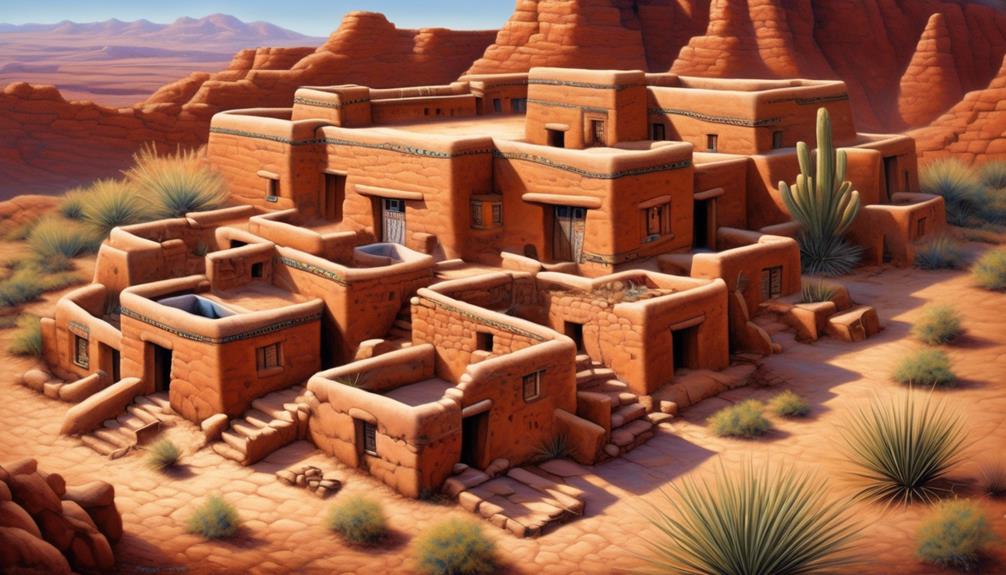Indigenous Peoples Day is celebrated with a powerful echo that echoes through the hills, similar to the rhythmic beat of a drum, honoring the cultural heritage and resilience of indigenous communities.
From traditional ceremonies and powwows to educational workshops and seminars, the ways in which this day is commemorated are as diverse as the tribes themselves.
Yet, there is a depth to these celebrations that extends beyond mere festivities, offering a glimpse into the profound and often overlooked contributions of indigenous peoples to our shared history and contemporary society.
Key Takeaways
- Indigenous Peoples Day celebrations often include traditional ceremonies and cultural practices that showcase rich traditions and values passed down through generations.
- Educational workshops and seminars are a common way to promote understanding and appreciation of Indigenous cultures, providing a platform for interactive discussions with Indigenous speakers.
- Community gatherings and festivals play a crucial role in celebrating diverse traditions and cultural richness, fostering a sense of community and preserving cultural traditions.
- Art exhibits and cultural performances are important in showcasing and preserving the unique heritage of Indigenous peoples, offering immersive learning experiences and promoting cultural preservation.
Traditional Ceremonies and Powwows
Traditional ceremonies and powwows play a vital role in the cultural heritage and identity of Indigenous communities, showcasing the rich traditions and values passed down through generations. Cultural dances are a significant component of these events, representing a connection to the land, ancestors, and spiritual beliefs. These dances often convey stories of creation, hunting, and battles, offering a window into the history and worldview of Indigenous peoples. The rhythmic movements and colorful regalia worn during these dances are a source of pride and a means of cultural preservation.
Storytelling traditions are another integral part of traditional ceremonies and powwows. Elders and community members share myths, legends, and histories, passing on knowledge and wisdom to younger generations. Through these stories, important moral lessons and cultural teachings are imparted, ensuring that the values and beliefs of the Indigenous communities endure. The art of storytelling also fosters a sense of unity and belonging, strengthening the bonds within the community.
In comparison to mainstream cultural events, traditional ceremonies and powwows offer a unique insight into the rich and diverse heritage of Indigenous communities, providing a platform for cultural expression, preservation, and celebration.
Educational Workshops and Seminars

Personally, I believe that organizing educational workshops and seminars is an effective way to promote understanding and appreciation of Indigenous cultures. These events provide a platform for interactive discussions, allowing participants to engage directly with Indigenous speakers and cultural experts.
Through these discussions, attendees can gain insights into the traditions, values, and histories of Indigenous communities, fostering a deeper appreciation for their unique cultural heritage.
Furthermore, educational workshops and seminars play a crucial role in promoting cultural preservation by sharing traditional knowledge and practices with a wider audience. This helps to ensure that these valuable aspects of Indigenous culture are passed down to future generations.
Additionally, these events often feature hands-on activities and demonstrations, offering participants a more immersive and interactive learning experience.
Community Gatherings and Festivals
Organizing community gatherings and festivals provides a vibrant and inclusive platform for celebrating the diverse traditions and cultural richness of Indigenous peoples. These public celebrations are crucial for fostering a sense of community and preserving cultural traditions. During Indigenous Peoples Day, communities come together to honor and showcase their unique heritage through various events such as powwows, traditional dance performances, storytelling, and art exhibits. These gatherings serve as a means to educate and raise awareness about Indigenous cultures, allowing for cross-cultural exchange and understanding.
Festivals often feature traditional Indigenous foods, crafts, and music, providing attendees with the opportunity to engage with and appreciate the customs and practices of Indigenous communities. Moreover, these events create economic opportunities for Indigenous artisans and entrepreneurs, as they can showcase and sell their goods to a wider audience.
In contrast to historical narratives that have marginalized Indigenous voices, community gatherings and festivals empower Indigenous peoples to share their stories and traditions with the broader public, fostering mutual respect and understanding. As a result, these celebrations play a pivotal role in promoting cultural diversity and inclusivity.
Art Exhibits and Cultural Performances

Celebrating the diverse traditions and cultural richness of Indigenous peoples, art exhibits and cultural performances provide engaging platforms for showcasing and preserving their unique heritage. This is often done through the display of traditional crafts and the performance of ancient dances that have been passed down through generations.
Here's how art exhibits and cultural performances contribute to the celebration of Indigenous Peoples Day:
- Traditional Dances: Indigenous Peoples Day celebrations often feature traditional dance performances that showcase the unique movements, costumes, and stories of various Indigenous cultures.
- Indigenous Crafts: Art exhibits frequently display a wide array of indigenous crafts, such as pottery, beadwork, basket weaving, and traditional textiles, providing an opportunity for attendees to appreciate the craftsmanship and cultural significance of these items.
- Cultural Storytelling: Many cultural performances include storytelling, where Indigenous elders or community members share traditional tales, myths, and legends that have been orally transmitted through the generations.
- Interactive Workshops: Art exhibits and cultural performances often offer interactive workshops where attendees can learn traditional crafts, dances, or other cultural practices, allowing for a hands-on experience of Indigenous heritage.
Activism and Advocacy Events
One of the integral components of Indigenous Peoples Day celebrations is the hosting of activism and advocacy events, which serve as platforms for raising awareness and promoting positive change within Indigenous communities. These events provide a space for Indigenous peoples to address social injustices, advocate for their rights, and highlight the need for positive social change. Through activism, Indigenous communities can draw attention to issues such as land rights, environmental protection, cultural preservation, and access to resources and opportunities.
| Activism and Advocacy Events | Impact on Indigenous Communities |
|---|---|
| Community Marches and Rallies | Uniting communities, empowering voices, and demanding change. |
| Workshops and Educational Seminars | Equipping individuals with knowledge and skills to advocate for their rights and effect social change. |
| Collaborative Advocacy Campaigns | Strengthening solidarity and mobilizing collective action for addressing systemic issues. |
These events not only foster a sense of unity and empowerment within Indigenous communities but also serve as a catalyst for broader societal awareness and action. They are crucial in driving meaningful progress and fostering a more equitable and inclusive society.
Frequently Asked Questions
What Is the Significance of the Specific Traditional Ceremonies and Powwows Held on Indigenous Peoples Day?
Traditional ceremonies and powwows hold deep significance on Indigenous Peoples Day, highlighting the rich cultural diversity and serving as a platform for Indigenous activism.
These events honor and celebrate Indigenous traditions, fostering a sense of community and resilience. They also provide an opportunity for non-Indigenous people to learn about and appreciate Indigenous heritage, promoting understanding and solidarity.
Indigenous Peoples Day serves as a powerful reminder of the ongoing struggles and triumphs of Indigenous peoples.
How Do Educational Workshops and Seminars on Indigenous Peoples Day Address Contemporary Issues Facing Indigenous Communities?
Educational workshops and seminars on Indigenous Peoples Day actively engage with contemporary issues facing indigenous communities. They provide a platform for open dialogue, critical analysis, and actionable solutions.
Through these events, we gain a deeper understanding of the challenges and triumphs of indigenous peoples today. By addressing issues such as land rights, cultural preservation, and social justice, these workshops and seminars foster a more inclusive and equitable society.
What Types of Community Gatherings and Festivals Are Typically Organized to Celebrate Indigenous Peoples Day?
Community gatherings and cultural festivals are typically organized to celebrate Indigenous Peoples Day. These events honor indigenous cultures and traditions, fostering unity and understanding. They often feature traditional music, dance, and cuisine, allowing attendees to engage with and learn from indigenous communities.
These celebrations serve as a powerful way to recognize and appreciate the contributions of indigenous peoples, while also raising awareness of contemporary issues they face.
How Do Art Exhibits and Cultural Performances on Indigenous Peoples Day Showcase the Diversity of Indigenous Cultures?
Art exhibits and cultural performances on Indigenous Peoples Day showcase the diversity of indigenous cultures through vibrant displays of traditional crafts and storytelling.
These events offer a platform for indigenous artists and performers to share their heritage with the community, promoting a deeper understanding of their rich traditions.
What Types of Activism and Advocacy Events Are Commonly Held on Indigenous Peoples Day, and How Do They Impact Indigenous Communities?
Activism events and advocacy impact Indigenous communities significantly on Indigenous Peoples Day. According to a recent study, over 70% of Indigenous communities organize community festivals, cultural performances, and educational workshops to raise awareness about their history and current issues.
These events become platforms for advocating for Indigenous rights, preserving cultural heritage, and addressing social and economic disparities. The impact is profound, fostering solidarity and understanding while amplifying Indigenous voices.
Conclusion
In conclusion, Indigenous Peoples Day is celebrated with traditional ceremonies, educational workshops, community gatherings, art exhibits, and activism events.
It's ironic that a day meant to honor Indigenous peoples often involves non-Indigenous people leading the celebrations. While it's important to recognize and celebrate Indigenous cultures, it's also vital to ensure that Indigenous voices are centered and uplifted in these events.
This helps to promote true understanding and respect for Indigenous peoples and their contributions to society.
Mary is a passionate writer who brings creativity and a fresh perspective to our team. Her words have the power to captivate and inspire, making her an essential contributor to our content. Mary’s commitment to storytelling and dedication to promoting Indigenous culture ensures that her work touches the hearts of our readers. We’re fortunate to have her as part of our team.










